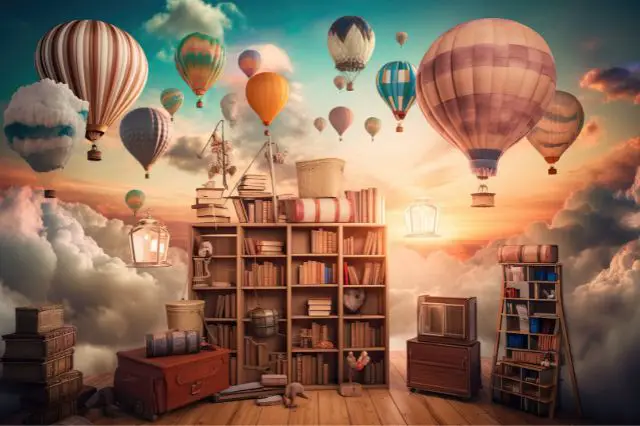Education
Beyond Words: The Visual Magic of Portland’s Book Illustrators


As we delve into the pages of a book, we set forth on a journey to realms uncharted, characters awaiting discovery, and sentiments previously unexperienced.
Yet, frequently, the enchantment goes beyond mere words—it emerges from the dynamic strokes of a brush, the vibrant palettes of color, and the skillful lines crafted by Portland illustrators. Nestled in the heart of this creative haven and literary enclave, a group of exceptional illustrators are conjuring visual wonders that elevate the storytelling encounter.
Join us as we explore the universe inhabited by these gifted artists, transcending the limits of language to enter a domain where visuals and narratives entwine seamlessly.
The Symphony of Words and Images
In a harmonious marriage of text and visuals, book illustration breathes a new dimension into storytelling. Children’s books, graphic novels, and even some adult literature are adorned with illustrations that illuminate the narrative and create a symbiotic relationship between words and images. Portland, often dubbed the “City of Books,” thrives in this artistic synergy, boasting a community of illustrators whose work ranges from whimsical and fantastical to thought-provoking and emotionally resonant.
A Journey Through Imagination: Children’s Book Illustrators
Children’s literature is a playground of creativity, and Portland’s illustrators are the architects of this imaginative wonderland. With a keen understanding of a child’s mind, artists like Carson Ellis and Carson Kugler craft visuals that expand young readers’ horizons. Ellis, known for collaborating with authors like Colin Meloy, brings forth enchanting worlds through intricate details and a vibrant color palette. Kugler, on the other hand, engages young minds with a blend of humor and heart, capturing the essence of childhood in every stroke.
Where Graphic Novels and Art Collide
Graphic novels transcend traditional storytelling, relying heavily on visual sequences to convey emotions and plotlines. Portland’s graphic novel illustrators have elevated this genre to an art form, exemplifying the power of visual storytelling. Lucy Bellwood, celebrated for her work in “Baggywrinkles” and “100 Demon Dialogues,” melds illustration with personal narrative, allowing readers to embark on intimate journeys through her art. The streets of Portland come alive in intricate detail as artist Joe Sacco delves into non-fiction graphic novels, providing readers with a unique blend of illustration and investigative journalism.
Visual Metaphors in Adult Literature
While illustrations are often associated with children’s and graphic novels, they have also found a niche in adult literature. Portland’s illustrators are breaking boundaries by introducing visuals that enhance the reading experience for mature audiences. In works such as Lidia Yuknavitch’s “The Book of Joan,” David Chelsea’s evocative illustrations serve as visual metaphors, adding depth to complex themes. This marriage of art and literature opens new avenues for readers to explore emotions and concepts beyond the constraints of words alone.
The Craft Behind the Magic: Illustrators’ Studios
The creative process of an illustrator is a journey in itself. Portland’s illustrators offer a glimpse into their artistic sanctuaries, where imagination takes shape. Studios are adorned with sketches, color palettes, and mementos that inspire their work. The natural beauty of the Pacific Northwest often finds its way onto their canvases, infusing illustrations with the essence of the region. As these artists share their spaces through social media and open studios, enthusiasts gain insight into the meticulous craft that underlies each stroke.
Fostering a Community of Creativity
Portland’s literary and artistic scenes are tightly interwoven, fostering a vibrant community where writers and illustrators collaborate to birth captivating stories. Literary events and book launches often feature live illustration sessions, where artists breathe life into characters as authors read their prose aloud. This synergy not only enriches the creative process but also connects readers to the visual and written worlds in an intimate and interactive manner.
Inspiring the Next Generation
As Portland’s illustrators captivate readers of all ages, they also play a pivotal role in inspiring the next generation of artists. Workshops, classes, and mentorship programs offered by these illustrators provide budding talents with the tools and guidance they need to explore their creativity. The local schools and libraries serve as stages for illustrators to share their expertise, fostering a cycle of inspiration that ensures the continuation of Portland’s visual storytelling legacy.
Beyond Portland: A Global Impact
The visual magic conjured by Portland’s illustrators extends far beyond the city’s borders. Through the internet and social media, their work transcends geographical constraints, reaching audiences around the world. The enchanting illustrations resonate universally, transcending language barriers and cultural differences. In this digital age, the collaboration between words and images knows no bounds, forging connections that span continents and touch hearts across the globe.
Capturing Culture: Cultural Diversity in Illustrations
Portland’s book illustrators are not only masters of technique but also champions of diversity. Through their illustrations, they reflect the rich tapestry of cultures that make up the city’s vibrant community. Illustrators like Tatyana Ostapenko infuse their work with multicultural elements, celebrating different backgrounds and experiences. This representation not only resonates with readers from diverse backgrounds but also educates and fosters empathy among those who may be encountering new cultures through the pages of a book.
Environmental Echoes: Nature’s Presence in Illustrations
Nestled in the heart of the Pacific Northwest, Portland’s illustrators find themselves surrounded by nature’s grandeur. This natural influence finds its way into their illustrations, creating a symbiotic relationship between art and the environment. Illustrators like Susie Ghahremani skillfully incorporate flora and fauna into their work, echoing the region’s commitment to environmental conservation. These visual odes to nature serve as reminders of the delicate balance between human creativity and the world that inspires it.
The Evolution of Technology: Digital Illustration Mastery
As the world hurtles into the digital age, the field of illustration has evolved to embrace technology’s boundless possibilities. Portland’s illustrators have seamlessly integrated digital tools into their artistic arsenal, expanding the horizons of their creations. Artists like Mike Russell demonstrate mastery in digital illustration, pushing the boundaries of what can be achieved through a digital canvas. This blend of traditional artistic sensibilities with modern technology not only showcases the adaptability of Portland’s illustrators but also underscores the enduring power of their craft.
A Visual Tapestry that Enriches Literature
In the heart of Portland’s literary landscape, book illustrators weave a visual tapestry that enriches the written word. From children’s books to adult literature, their artistry enhances the reading experience, evoking emotions, and expanding horizons. This city, with its creative pulse and deep appreciation for the arts, provides a nurturing haven for illustrators to flourish and push the boundaries of their craft.
Conclusion: Beyond Words, a Lasting Impression
As we close the chapter on our exploration of Portland’s book illustrators, one thing becomes clear: their work leaves an indelible mark on both the literary and artistic worlds. The visual magic they create resonates across ages, cultures, and borders, uniting us through stories that are brought to life by their skilled hands. In Portland, the city of words and images, these illustrators continue to remind us of the enchantment that lies beyond the realm of words, inviting us to lose ourselves in the intricate dance of visuals and narratives. So, as you pick up your next book, take a moment to appreciate the illustrators who illuminate the pages and take you on journeys that are truly beyond words.
Education
10 Most Effective Tips to Write an Essay When You Have No Motivation


Writing requires a clear mind and a comfortable environment. It implies a combination of objectivity and desire to complete an assignment. However, these factors are not always available. Everyone experiences periods of reduced motivation, especially when working on challenging or uninteresting tasks. This article outlines ten strategies you can use to write an essay when you have no motivation.
How to Start Writing an Essay When You Have No Motivation
1. Reorganize
Reorganizing your working environment is one of the easiest ways to get motivated to write an essay. You can start with decluttering your workspace, placing items in their right positions, and re-establishing order. Whether you write from an office or your dining room table, you need the space to be tidy and appealing.
Besides, the reorganization itself is a way to refocus your attention on other meaningful tasks. It acts as a redirection technique, allowing you to take your mind off the writing itself. Cleaning and organizing your workspace also acts as an achievable task, boosting your confidence and self-esteem.
2. Change your strategy
Sometimes, your motivation to write dwindles as your paper progresses. In such cases, restrategizing becomes the best technique for staying motivated while writing essays. It involves adopting a different approach in the middle of the writing process. Restrategizing is just a fancy way of saying “trying something else.”
In other words, when your initial plan fails, try another one. If you plan to write in the morning, and it no longer works, shift your assignment to late nights or lunchtime. If you were typing on your PC, and it now seems boring, try a desktop computer or writing with your hands. Whatever helps you focus on your writing should be the preferred choice.
3. Revitalize your mind
One of the most notorious causes of writer’s block is the lack of inspiration. Not finding a good reason to complete your assignment can distract you from the actual work. This situation usually reflects a mind block or the inability to conceptualize issues correctly. Hence, revitalizing your mind is one of the best ways to motivate yourself to write.
Boost your thinking with notable self-care techniques, sleep, or exercise. Freshen your thinking with a walk in the park or a swim. Get some fresh air or talk to your favorite person.
4. Free write
Sometimes, writer’s block is your mind’s way of telling you to try something else. It’s the clearest indicator of a failed approach. Your mind may be trying to tell you that you are doing it all wrong. When you lose your motivation to write, try writing without thinking. Freewriting is an ancient technique for brainstorming ideas.
It helps you review what is on your mind. Freewriting helps you document your thought process without distractions. You get to write a college essay without grammar rules and punctuation restrictions. You don’t even need to apply a structure or writing style. This way, you can refocus your energy and redirect your work toward the important task.
5. Use individual starbursting
Starbursting can boost your writing motivation by highlighting your strengths and weaknesses in the topic of interest. It helps you identify what you know or need to know in that area. For example, CustomWritings – pro essay writers are trained to utilize Starbursting to explore topics and expand their knowledge. As a result, the academic writers produce stellar papers with little effort.
You too can utilize this technique to overcome writer’s block or motivate yourself to write. By asking questions about your topic and generating simplistic responses without research, you can identify areas of improvement and plan your work better. You can also use this strategy to find better methods of tackling your assignment.
Starbursting involves asking the what, where, why, how, and when questions relating to your topic. If you can find answers to these simple questions, you can overcome your lack of motivation.
Five Tips to Get Motivated to Write an Essay
1. Do something else
Working on something interesting is one of the best ways to rejuvenate your motivation. Sometimes, all you need is a small win or a moment of excitement to kick-start the flow of ideas for writing. Working on another project helps you redirect your energy toward something more appealing. Take a hike, read a book, watch a movie or sleep, whatever it takes to get your mind off your writing project. Usually, your hobbies are the go-to solutions for boosting your motivation.
2. Just start
The most notable culprit in lost motivation is procrastination. Students who procrastinate are more likely to lack motivation for writing. Thus, writing an assignment sooner rather than later is always the best strategy. With or without motivation your assignment remains one of the most important tasks in your school life. Write like your life depends on it. Instead of postponing to a later date or time, utilize brainstorming techniques to find the best ideas.
3. Use the Pomodoro technique
This approach recognizes that people’s attention is not always guaranteed. We all have attention spans and bouts of distraction. The Pomodoro technique involves subdividing your tasks into 25-minute sessions. You can only focus on one task for 25 minutes and take breaks between tasks to rejuvenate and re-energize. This strategy can help you regain your writing motivation. However, you must have a plan for the Pomodoro technique to be effective. You must understand your task and break it down into smaller tasks.
4. Create a mind map
Mind mapping is one of the oldest and most effective tricks writers use to keep themselves motivated. A mind map is a pictorial representation of your thinking about a topic. Usually, it starts with the main idea and highlights the related issues radiating from it. Mind mapping helps you visualize your writing project from a central location around your topic. You can use this strategy to jump-start your mind when you have no motivation. Students who use mind maps tend to complete assignments earlier, especially when working on challenging topics.
5. Create an outline
As a matter of fact, outlining is another one of the most useful tips for improving your motivation for writing. With properly developed outlines, writers produce excellent papers effortlessly. The reduced writer’s input in the writing process is one of the easiest ways to motivate yourself. In this case, you can start with the simplest steps, like a one-person brainstorming session.
Here, you create a list of relevant topics, subtopics, and headers for your paper. You can also generate alternative thesis statements based on the main ideas and create a simplistic outline. This is usually the first step in writing. Outlining helps you organize your thoughts and plan your paper based on the available ideas.
Education
Importance of Field Trips in Education


Bangalore boasts prestigious institutions on a global scale, such as the renowned Indian Institute of Science located in Yeshwanthpur, the esteemed Indian Institute of Management (IIM Bangalore) situated along Bannerghatta Road, along with the Indian Institute of Information Technology and the Institute of Bioinformatics and Applied Biotechnology. The educational standards in the city are consistently elevated, rapidly aligning with the demands of the emerging Internet Economy.
Field trips, a valuable and cherished part of education, have played a pivotal role in the development of students across the globe and in creating the best isc schools in Bangalore. In ISC schools, these excursions provide students with unique opportunities to apply classroom knowledge to the real world, enhancing their educational experience. In this article, you will delve into the importance of field trips in the context of best isc schools in India.
Fostering Practical Learning
Field trips offer students the chance to apply theoretical knowledge in real-life situations. Students often find it easier to grasp complex concepts when they see them in action. This experiential learning approach is particularly beneficial in isc schools in India, known for their rigorous academic curriculum. Field trips provide a breath of fresh air, making learning more engaging and practical.
Cultural and Historical Immersion
India is a land rich in culture and history. Field trips to heritage sites and museums allow students to immerse themselves in the country’s past and appreciate the significance of its traditions. These experiences foster a deeper understanding of their own culture and the world around them.
Strengthening Teamwork and Social Skills
Field trips encourage interaction among students in a more relaxed and natural environment. Working in groups, sharing responsibilities, and problem-solving during excursions help develop valuable teamwork and social skills. These skills are crucial for achieving success in a world that increasingly values collaboration.
Boosting Creativity
Exposure to new environments can stimulate students’ creativity. Whether it’s a visit to an art gallery, a science museum, or a botanical garden, students have the opportunity to draw inspiration from various sources. Schools with isc boards recognise the importance of nurturing creativity alongside academic excellence.
Promoting Environmental Awareness
Many field trips are geared towards environmental education. Visiting wildlife sanctuaries, nature reserves, or sustainable farms can instil a sense of responsibility towards the environment. In a world grappling with environmental challenges, promoting eco-consciousness is vital, and ISC schools contribute significantly to this cause.
Cognitive Development
Field trips often involve critical thinking and problem-solving activities. This challenges students to apply their academic knowledge to solve real-world problems, enhancing their cognitive abilities. ISC schools prioritise holistic development, and field trips are a prime example of this approach.
Broadening Horizons
Field trips provide students with a window to the wider world. They expose students to diverse cultures, traditions, and ways of life, fostering open-mindedness and tolerance. These qualities are invaluable in a globalised world.
Connecting with History
For ISC schools, field trips offer the chance to connect with the nation’s history. Students can visit historically significant places, making history lessons come alive. They can stand where freedom fighters once stood or explore ancient ruins, creating a profound connection with the past.
Instilling Lifelong Learning
The experiences gained on field trips often stay with students throughout their lives. Visiting a planetarium might ignite a lifelong interest in astronomy, or a trip to a science centre may inspire a career in research. ISC schools aim to instil a love for learning that goes beyond textbooks and examinations.
Conclusion
In summary, field trips hold immense significance in best isc schools in Bangalore. They facilitate practical learning, cultural immersion, teamwork, independence, and creativity. Moreover, they promote environmental awareness, cognitive development, and a broader worldview. Field trips also help students connect with their history and instil a love for lifelong learning.
ISC schools understand the profound impact that well-planned field trips can have on a student’s overall development. These excursions enrich education, making it a more engaging and holistic experience. As ISC schools continue to provide the best in education, they will undoubtedly continue to incorporate field trips as an essential component of their educational philosophy.
Education
Skills for the Real World: How Authentic Assessment Prepares Students for Future Challenges


In an evolving educational landscape, there’s an increasing emphasis on assessments that not only measure what students know but also their ability to apply knowledge in real-world contexts. This shift from traditional, standardized tests to more holistic evaluation methods introduces a concept known as ‘authentic assessment’.
At its core, authentic assessment transcends the four walls of the classroom, preparing students for the multifaceted challenges that await them in their professional and personal lives.
The Shift from Rote Learning
Historically, educational systems across the globe have leaned heavily towards rote learning. Students were often encouraged to memorize vast amounts of information, regurgitating it during exams. These traditional methods, while having their merits, primarily assessed memory rather than understanding or application.
They seldom gave insights into a student’s ability to tackle complex problems, work in teams, or think critically—skills indispensable in today’s dynamic world. The limitations of rote learning and standardized testing became more evident as educators and policymakers began recognizing the need for an educational approach that mirrored real-life scenarios.
Principles of Authentic Assessment
Authentic assessment is grounded in several foundational principles that distinguish it from its traditional counterparts. First, it emphasizes the application of knowledge rather than mere recall. Students are asked to perform tasks that demonstrate meaningful application of essential knowledge and skills. Second, these tasks are often open-ended and can have multiple solutions, reflecting the complexity of real-world challenges.
Furthermore, authentic assessment often integrates multiple disciplines, just as real-life problems do. For example, a project might incorporate elements of mathematics, science, and communication skills. Lastly, these assessments are often collaborative, mirroring the teamwork and interpersonal communication required in many professional settings.
Bridging the Gap: Classroom to Career
One of the most compelling arguments in favor of authentic assessment is its direct relevance to the challenges that await students post-graduation. The tasks and projects assigned under this approach are closely aligned with professional tasks, be it designing a product, drafting a business proposal, or conducting scientific research.
By engaging in these assessments, students get a taste of the demands of their future careers, preparing them not just academically, but also mentally and emotionally. It’s an early immersion into the realities of their chosen fields, ensuring a smoother transition from academia to the professional realm.
Enhancing Soft Skills Through Authentic Assessment
While technical proficiency and academic knowledge remain paramount, the modern workplace often demands an equally strong set of soft skills. Authentic assessment, with its real-world approach, naturally cultivates these invaluable skills. Tasks often require students to communicate their ideas effectively, work collaboratively within teams, and think creatively to find novel solutions.
Through presentations, group projects, and interdisciplinary assignments, students also hone skills like adaptability, leadership, and empathy. In an era where emotional intelligence is prized alongside cognitive abilities, authentic assessments serve as an essential bridge to holistic personal and professional development.
Addressing Concerns: Is Authentic Assessment for Everyone?
While the merits of authentic assessment are many, it’s essential to recognize and address potential criticisms and challenges. One concern is the subjective nature of evaluation; without standardized tests, how do educators ensure consistent and fair grading?
There’s also the logistical challenge of implementing such assessments on a large scale, given the unique nature of each task. Additionally, not all students might be comfortable with this approach initially, particularly if they’re transitioning from a more traditional educational background.
However, with proper training, clear rubrics, and consistent feedback, many of these challenges can be addressed. Furthermore, by gradually introducing authentic assessments alongside traditional ones, students and educators can transition more smoothly into this new paradigm.
The Role of Technology in Facilitating Authentic Assessment
In the 21st century, technology has become an indispensable ally in the realm of education, and authentic assessment is no exception. Digital platforms now offer educators tools to create, implement, and evaluate real-world tasks seamlessly. Virtual reality can immerse students in simulated real-world scenarios, from engineering challenges to historical re-enactments.
Artificial intelligence can aid in providing personalized feedback, ensuring that each student’s unique learning path is acknowledged and nurtured. Moreover, with the rise of online collaboration tools, students can work on group projects across geographies, fostering global perspectives and cross-cultural communication skills.
The fusion of technology with authentic assessment not only amplifies its impact but also prepares students for a digitized, interconnected world.
The education landscape is ever-evolving, adapting to the needs of a dynamic world. As we move further into the 21st century, the quest for methods that prepare students not just academically, but also for the multifaceted challenges of the real world, becomes all the more pertinent.
Authentic assessment emerges as a beacon in this pursuit. While it does present certain challenges, its benefits — from nurturing invaluable soft skills to ensuring seamless transitions from classrooms to careers — are undeniable.
-



 Quotes4 years ago
Quotes4 years ago125 Inspirational Car Quotes and Captions to Celebrate Your New Car
-



 Growth4 years ago
Growth4 years ago188 Deep Hurt Quotes with Images
-



 Quotes3 years ago
Quotes3 years ago148 Romantic Love Quotes for Her from the Heart
-



 Quotes3 years ago
Quotes3 years ago185 Cute Boyfriend Quotes for the Guy You Love
-



 Quotes3 years ago
Quotes3 years ago141 Best Heart Touching Quotes about Love, Life, and Friendship
-



 Quotes3 years ago
Quotes3 years ago134 Time Flies Quotes for the Unforgettable Moments
-



 Quotes3 years ago
Quotes3 years ago122 Inspirational Kite Quotes That’ll Make You Wanna Fly Right Now
-



 Quotes4 years ago
Quotes4 years ago101 Powerful Black Women Quotes to Empower You







